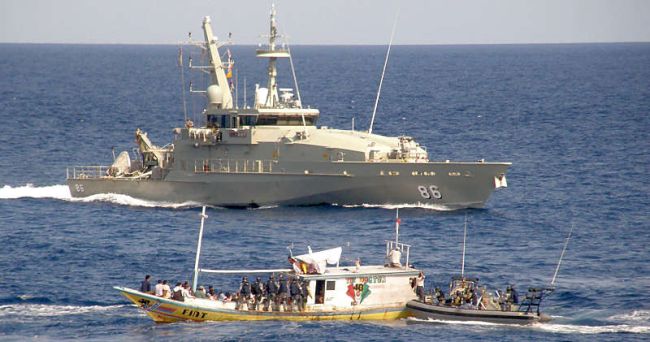“Well actually it’s both the Aircraft Carrier Alliance [ACA] and the Joint Combat Aircraft Team,” he said. “From the aircraft side the team has to be satisfied it is safe to operate the aircraft at sea efficiently. So in terms of the JCA safety case, it is critical that we are able to demonstrate safe F‑35C recovery operations.
“From the ACA perspective, we have to prove that the ship is safe to operate the aeroplane so we have to provide sufficient visual landing aids to demonstrate to our safety case that it works. Both teams must be confident that what we will be putting on the deck works. We will be making sure it is a win/win for both teams.”
Landing on the new carriers — what the pilot sees
Aircraft approach the stern as the carrier steams into the wind. Pilots aim for the second or third of the arrestor wires — the safest, most effective target.
 |
| The BAE Systems’ simulator at Warton — from left: the simulator controller, the view of the simulated aircraft, and the pilot in the cockpit [Pictures: Andrew Linnett, Crown Copyright/MOD] Source: Ministry of Defence, UK Click to enlarge |
Aircraft are guided by deck personnel — the Landing Signal Officers — via radio and the collection of lights on deck.
When the aircraft has landed the pilot powers up the engines to make sure that, if the tailhook doesn’t catch a wire, the plane is moving fast enough to take off again.
Pilots will look at the Improved Fresnel Lens Optical Landing System for guidance — a series of lights and lenses on a gyroscopically-stabilised platform.
Lenses focus light into narrow beams directed into the sky at various angles. Pilots will see different lights depending on the plane’s angle of approach. On target, the pilot will see an amber light in line with a row of green lights.
If the amber light is above the green, the plane is too high; below green it is too low. Much too low and the pilot will see red lights.
So how did I do? My first attempt saw my F‑35 scream way past the carrier, too fast, too high, and with no hope of landing. A second was just as wayward, overshooting and just missing the island superstructures, necessitating a stomach-churning go-around.
A third and final approach needed a last-second drop in height, allowing me to find the last of the arrestor wires, ending in a landing more akin to Fosbury than any of the elite pilots who have been using the simulator for their landings.
The flight deck has about 250 metres of runway distance for landing aircraft. A runway on land would be around 12 times longer. And doesn’t move.
Landing on a carrier deck pitching up and down by up to 30 feet (9m) in a rough sea can be daunting enough. A pilot has to place the aircraft’s tailhook in a precise part of the deck 150 feet (46m) long by 30 feet (9m) wide to catch the arrestor wires, and do it at night too.
The arresting wire system can stop a 25-tonne aircraft travelling at 150 miles per hour (240km/h) in just two seconds in a 300-feet (90m) landing area. Deceleration is up to 4Gs.
This article is taken from the January 2012 edition of desider — the magazine for Defence Equipment and Support.
Press release
Ministry of Defence, UK

 von
von 